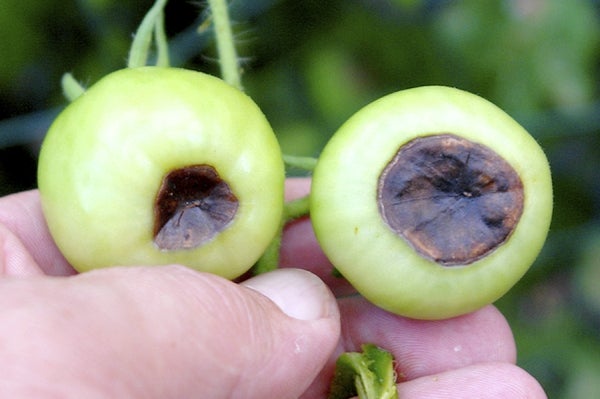Top five tomato problems
Published 12:00 am Friday, June 3, 2016

- Blossom end rot is a common tomato problem that can strike at any time. Cooperative Extension
By Amy-Lynn Albertson
Rowan County Extension Director
Almost every gardener in Rowan County has at least one or two tomato plants set out. Our mild winter and wet weather might make for a difficult growing season.
Before you go out spraying chemicals willy nilly, it is necessary to understand the situation. Know who your enemy is before you choose your weapon. The first step in controlling an insect or a disease problem is learning how to identify correctly the pests you have.
Here is a list of the top five insects or diseases that cause problems on tomatoes and how to control them.
- Cutworm: Most cutworms cut off stems of plants at or near the soil line. Cutworms feed at night when temperatures are 65 degrees or higher. Cutworms usually do not eat plants beyond cutting through them, although some species will climb stalks and feed on the upper parts of the plants. When full-grown, the cutworms are 1-1/2 inches long. They curl up into a tight C shape when disturbed. Most cutworms are a dull color with little or no hair. There may be more than one generation of some species each year. Guard the plant base from cutworms with a wax paper collar about 3 inches high (2 inches above the ground and 1 inch below).
- Aphids: Aphids, or plant lice, feed on most vegetables. These insects cause the greatest damage when they suck juices from and inject saliva into plants. Many aphid species transmit viruses that cause diseases. Adults are soft-bodied, pear-shaped and may or may not have wings. Aphids may be green, pink, yellow or black. Nymphs resemble adults but are smaller and always wingless. These pests usually feed in clusters. Leaves appear shiny and are somewhat sticky when honeydew is present. Damage usually is minimal on tomatoes and often can be ignored. If aphids become a problem, several applications of insecticidal soap are quite effective.
- Tomato hornworm or tobacco hornworm: Tomato and tobacco hornworms feed on tomatoes, peppers, potatoes and related plants. These green worms are 3 to 4 inches long and can defoliate young plants. Mature tomato hornworms have eight L-shaped markings along each side of the body and a bluish-black horn near the rear end of the insect. Tobacco hornworms are decorated with diagonal white bars and have a red horn. Pick them off by hand.The caterpillars are susceptible to Bacillus thuringiensis (Bt), sold as Dipel or Thuricide), as well as to many common vegetable insecticides.
- Early Blight (Alternaria solani): Symptoms become prevalent during the hotter months. This disease produces brown to black, target-like spots on older leaves. If severe, the fungus also attacks stems and fruit. Affected leaves may turn yellow, then drop, leaving the fruit exposed to sunburn. Sanitation is the best control. Remove all diseased plant tissue on the ground, as the fungus overwinters on leaf debris. Do not plant tomatoes in the same place next year. Space plants farther apart to improve air circulation. Avoid overhead irrigation. If the infestation is heavy, sulfur dust may help protect new leaves from infection.
- Blossom end rot: This disease is nonparasitic, caused by a calcium deficiency in the developing fruit. The symptoms begin as a slight water soaked area on or near the blossom end of the fruit. The affected area darkens and enlarges in a widening circle. The calcium deficiency may be due to a lack of calcium uptake from the soil or to extreme fluctuations in water supply. One way to control blossom end rot is to make sure the soil pH is between 6.5-6.8. A soil test analysis will tell you the proper amount of lime to add to your soil. This should be done months before planting. Since blossom end rot is also associated with extremes in water supply, it is important to try to regulate the moisture supply in the soil. Mulching helps to maintain soil moisture. In general, plants need 1 inch of water per week in the form of rain or irrigation. If symptoms appear, it can be remedied by applying a foliar spray of calcium chloride.
For more information on tomato problems or other horticultural topics call the Rowan County Cooperative Extension on office at 704-216-8970.




